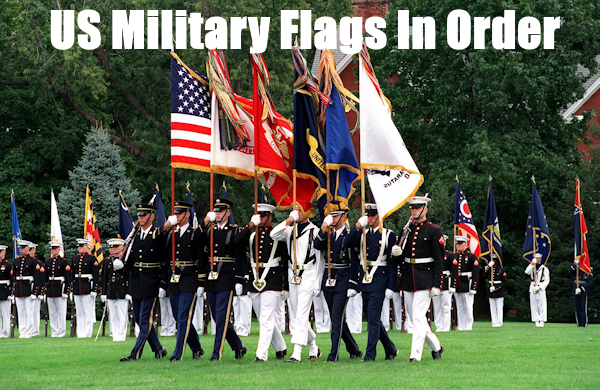What is the correct order for military flags?
The United States follows a specific procedure when observing the order of the flags.
Accordingly, it’s important to learn this distinction when several military flags are displayed together.
Learn more about the military flag order to make sure that you follow proper etiquette.
Related Article – American Flag Hanging Vertically Meaning (& How To Do It Right)
Table of Contents
U.S. Military Flags In Order
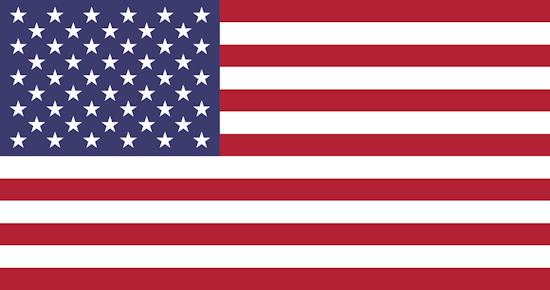
The United States Armed Forces are among the most elite and well-respected in the world.
As a result, the colors of the different military branches are often represented by their respective flags.
Military flags exist in each branch of the U.S. Armed Forces along with several specialty flags (more information, below).
For example, some military flags are witnessed every day while others only appear on certain occasions.
Moreover, various U.S. military flags are found flying over bases, camps, military academies, and aboard ships.
For this reason, it’s impossible to recognize every single military flag unless you become an expert in the matter.
Nonetheless, learning about some of the more noteworthy military flags goes a long way.
Additionally, knowing how to distinguish the correct order of military flags when they are presented together, is also crucial.
As such, consider the correct order of military flags when multiple branches of the U.S. Armed Forces are represented together.
From left to right, the correct order is:
- United States National Flag
- U.S. Army Flag
- Marine Corps Flag
- United States Navy Flag
- U.S. Air Force Flag
- Space Force Flag
- U.S. Coast Guard Flag
There are a few exceptions that change the order of precedence for military flags.
For example, if the Coast Guard is transferred to the Department of the Navy, the order of military flags changes.
Consequently, the U.S. Coast Guard flag precedes the Air Force flag in that situation.
Learn more about the most recent changes to the U.S. military flag order of precedence along.
Related Article – American Flag With Green Stripe Meaning
Military Flags in Order of Precedence Explained
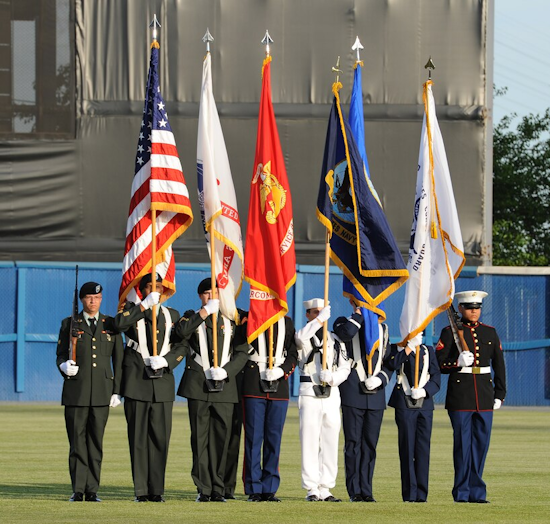
The order of military flags was established by the Department of Defense (DoD).
The purpose of the order of precedence was to create a universal method for displaying the numerous flags of color.
Accordingly, the general order of military flags is based on when the service branch was created.
Therefore, the order of precedence from the vantage of the viewer (left to right) is:
- United States Army
- Marine Corps (USMC)
- United States Navy
- U.S. Air Force (USAF)
- United States Space Force
- U.S. Coast Guard
Of course, the Star Spangled Banner, or National flag, supersedes all military flags in order of precedence, ranking first.
Thereafter, the order of flags is based on when the military branch was established with the exception of the Coast Guard.
Coast Guard Exception
The U.S. Coast Guard has actually been around far longer than both the Air Force and Space Force.
Be that as it may, the Coast Guard operates under the command of the Department of Homeland Security.
For this reason, the Coast Guard flag ranks last in order during times of peace.
However, the ranking of military flags changes during wartime, whereas the Coast Guard is under the command of the U.S. Navy.
In this event, the Coast Guard flag actually precedes the Air Force and Space Force flags in order of precedence.
Space Force Flag

Recently, the U.S. Armed Forces introduced the newest branch — the Space Force.
The new addition of the U.S. Space Force presented a few new challenges, including its ranking within flag order.
In the past, the date-of-origin rule has determined the position of military flags in order of precedence.
Nevertheless, the Space Force flag is an exception as it actually ranks above (and to the left) the Coast Guard flag.
The explanation for this is that the Coast Guard is generally under the direction of Homeland Security, not the Department of Defense (like the other military branches).
As such, the Coast Guard continues to rank last in order during times of peace.
Related Article – Upside Down American Flag Meaning: 7 Things You Didn’t Know
Order of Precedence (U.S. Military Flags with other flags)
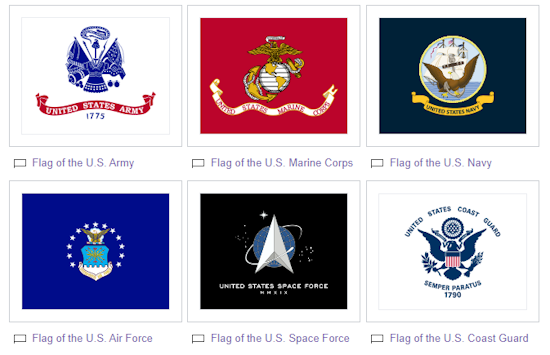
The Department of Defense Directive 1005.8 dictates the order of precedence for military flags.
It not only outlines the specific guidelines for the order of military flags but also how to display them with other types of flags.
As a result, these guidelines for proper flag etiquette apply to citizens who hang their flags outside homes or buildings, along with parades and sporting events.
The Department of Defense stipulates that the order of precedence of flags always places emphasis on the national flag.
Therefore, Old Glory is always found first when the observer is looking at a series of flags from left to right.
The same rules apply if the American flag is being displayed from a pole or stand, where it should always be on top or higher than the other flags.
Secondly, the Department of Defense mandates that state flags are the next series of flags in order of precedence.
Third, military flags are displayed in the correct order shown above (Army, Marines, Navy, Air Force, Space Force, Coast Guard).
Fourth, the ranking system determines that other types of flags, such as municipality flags or flags of organizations, follow in order of precedence.
The rules are not too specific thereafter, so long as citizens remember the basic principle:
- National Flag
- State Flags
- Military Flags
- Other Types of Flags
There are many alternative types of military flags like maritime and personal flags.
Generally, these types of flags fall under the fourth category based on order.
U.S. Maritime Flags
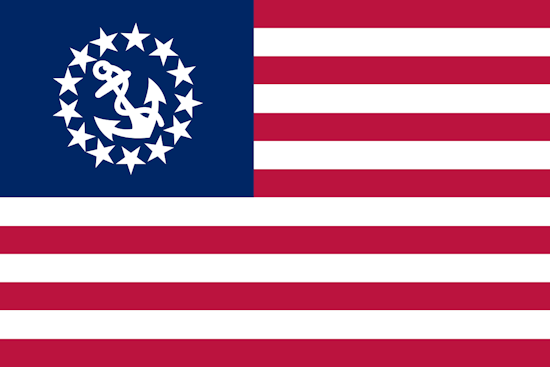
The United States has used maritime flags for many years.
Often, maritime flags are displayed on vessels and navy warships.
Maritime flags are allowed on military vessels with the exception of the U.S. Coast Guard.
The maritime flag looks identical to the national flag, but international rules determine its usage.
For example, U.S. vessels are required to display the maritime flag between sunrise and sunset in international waters.
The Coast Guard ensign flag, on the other hand, is distinct from the U.S. maritime flag. This distinction is used to show the vessel’s authority to stop, board, search, and investigate other vessels.
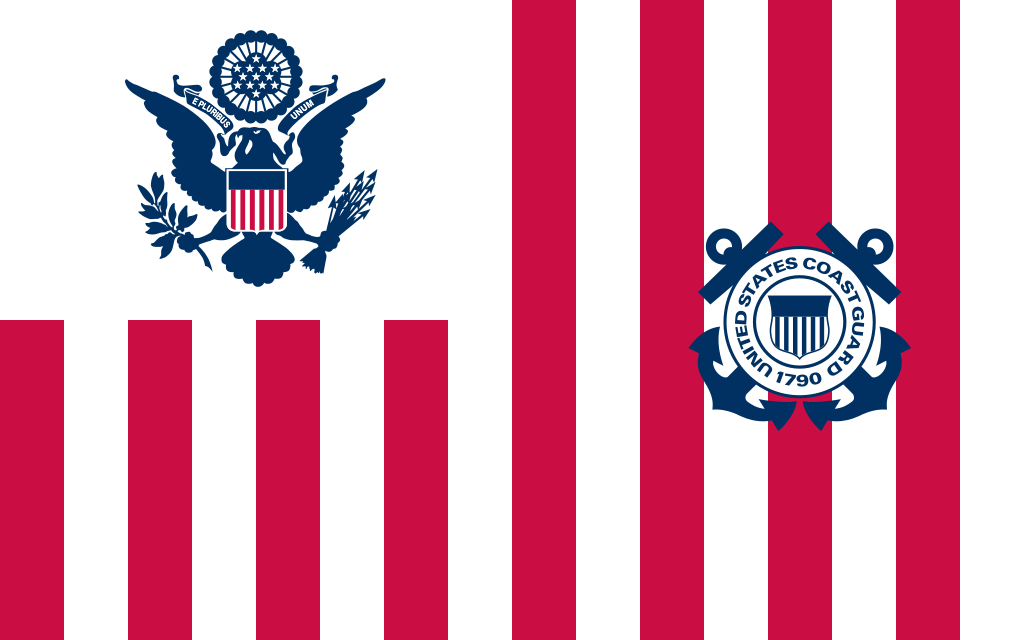
In the past, the appearance of maritime flags has shifted like the changes in the American national flag.
Moreover, the U.S. Navy and Coast Guard have their own variations, including the First Navy Jack.
Flag Officers
There are also military flags that were created for specific personnel or purposes.
For example, many high-ranking members of the military (generals, admirals, etc.) have their own personal flag assigned to represent their authority or command.
Furthermore, military officials within certain offices or billets have their own personal flags.
As a result, these types of military officials are referred to as “flag officers.”
Then, there is the President of the United States, who also has his own personal flag as commander-in-chief.
The Vice President, Secretary of Defense, and other high-ranking government officials are also recognized with various military flags.
Related Article – 31 Presidents That Served In The Military (& 15 That Didn’t)
Conclusion
It’s crucial to follow proper flag etiquette.
The rules established by the Department of Defense outline specific guidelines for the order of precedence of military flags.
Consequently, military personnel along with civilians need to recognize the correct order of military flags.
These rules apply to public and private gatherings, including parades and sporting events.
Featured Image Source – www.Wikipedia.org
- Ikon Pass Military Discount: Learn How To Save Big - January 31, 2025
- RTIC Military Discount: Find Out How To Save Big on Gear - January 30, 2025
- Traeger Military Discount: Learn How To Save Big on Smokers - January 28, 2025

